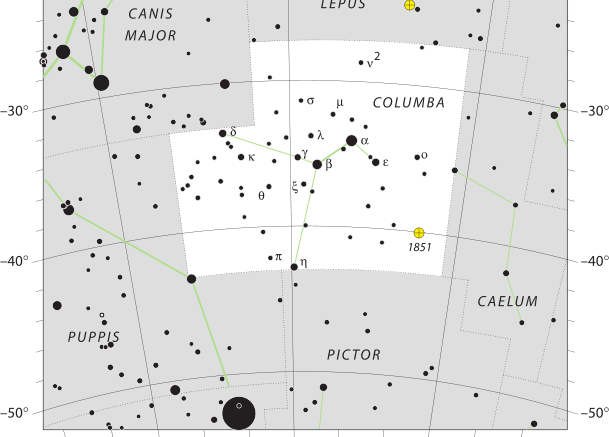Located in the southern constellation, Columba is a faint constellation designated in the late sixteenth century. The name Columba is Latin for dove. The constellation uses 1.31% of the southern celestial hemisphere, and is located just south of Canis Major and Lepus.
The first mention of Columba was on the constellation charts of Petrus Plancius, who was a 16th century Dutch astronomer and cartographer. In 1589, he created a celestial globe to help understand the areas around the south celestial pole.
| Applicable Information | |
| Visibility In Pacific Northwest | September to March |
| Best Times To View | February |
| Right Ascension | 05h 03m 53.8665s–06h 39m 36.9263s |
| Declination | −27.0772038°–−43.1116486° |
| Area | 270 square degrees |
| Main Stars | 5 |
| Brightest Object | α Col |
| Meteor showers | 0 |
| Messier objects | 0 |
| Neighboring Constellations | Lepus, Caelum, Pictor, Puppis, Canis Major |
The Name
The original name was Columba Noachi, which is not greek as there was a no mythology associated with the constellation. The name does refers to the Torah and biblical story of the Dove of Noah, which was the first bird to find land after the flood.
The story could also belong to the story of Argo, where a dove was sent out to lead the Argonauts to safety between the clashing rocks. The legend of the dove is supported by the brightest star in the constellation – Alpha – whose name is Phact, Arabic for “ring dove”.
Stars
The brightest star, Alpha Columbae has a magnitude of 2.7.
NGC 1851 a globular cluster in Columba appears at 7th magnitude which is resolvable in medium sized amateur telescopes under good conditions for those south of at greatest latitude +40°N.
Other deep sky objects in the constellation include NGC 1792, which is a spiral galaxy and NGC 1808, which is a Seyfert galaxy.
Make sure to check out other articles on the site, including a brief introduction to constellations, other constellation articles, and more!

Be the first to comment on "Columba"